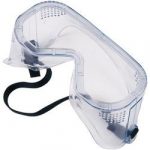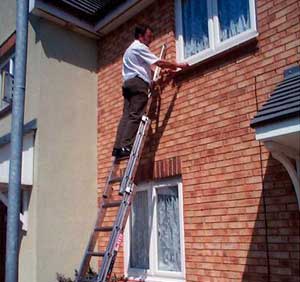Every year, thousands of people in the UK are injured whilst carrying out DIY and home improvement tasks around the home. Whilst many of these accidents are minor, it is still important to take all the safety precautions you can when doing any DIY.
These Home Improvement Safety Tips cover the very least you should think about before even opening your toolbox.
1. Protect Yourself – Goggles, gloves and masks are available for a reason! Whenever you are dealing with glass, solvent based paint and other potentially harmful or dangerous materials, make sure you wear the correct protective clothing. Spending a few extra pounds on safety equipment is better than spending a week in hospital! You can read more about getting the right safety equipment for your DIY and home improvement projects at the bottom of this page. 
2. Ventilation is important – When using ANY type of paint or varnish, chemical products (paint stripper, etc.,) or other potentially toxic materials, always ensure adequate ventilation. Always read the manufacturers instructions carefully, even if you don’t think the product is harmful.
3. The right tool for the job – Not everyone can afford to pay hundreds of pounds for a semi-professional drill, but simply making sure the tools you do have are suited to the job can save you from serious injury. You should also take care to check that any tool you are planning to use is in good condition and up to the job.
4. Storing Tools and Equipment – Store any DIY tools and equipment in a safe place, out of the way of children and pets. Secure them in a box or on a rack and do not let children play in areas where tools are stored unless they are supervised. If your tools are stored in a shed or outbuilding, make sure it is secure.
5. Cut the material, not yourself – Whenever you are cutting wood or other materials, always cut away from yourself whenever possible. Wear gloves and use a straight-edge when scoring wood, etc. When sawing, try to keep your hand away from the blade as it cuts. Saw blades can stick and jump out of the cut, causing very nasty wounds if you are not careful.
6. Power, power, power – When fixing or checking electrical appliances or connections, ALWAYS switch off the power at the mains and remove the fuse or circuit breaker (MCB). If you’re fixing an electrical appliance, switch off the appliance at the socket and pull out the plug. Always try to wear rubber-soled shoes when working on electrics and check for any current using a circuit testing screwdriver or probe before you touch any exposed wiring.
7. Be ready for Fire – Always keep a chemical fire extinguisher in the house (even if you are not planning DIY). You should NEVER use water to put out a fire in an electrical appliance, so a chemical extinguisher is essential.
8. Plastic is good – Almost all modern drills have a plastic body (many older drills will be encased in metal bodies). This is to reduce the risk of electric shock if you hit a wire or if the drill malfunctions. If you are still using an old, metal-bodied drill, consider replacing it as soon as possible.
9. Don’t hang loose! Avoid wearing loose clothing or jewellery, which could get caught in the drill. Overalls may not look very cool, but they serve to both save your clothing from damage and to keep loose clothing safe. Long hair should also be tied up when working with power tools. You really don’t want to experience getting your hair caught up in a drill motor!
 10. Ladders are Dangerous – Ladders are one of the main causes of DIY accidents! Always erect the ladder according to the manufacturer’s instructions. If possible, have someone holding the ladder at the bottom whilst you work, and make sure that the foot of the ladder is on a solid, clean surface whenever possible. If you can’t find anyone to hold the ladder, try to tie the bottom of the ladder to something at the base of the wall so that to bottom cannot slip outwards. Never lean to one side as you could lose balance. It is always better to move the ladder a few feet, than to risk leaning.
10. Ladders are Dangerous – Ladders are one of the main causes of DIY accidents! Always erect the ladder according to the manufacturer’s instructions. If possible, have someone holding the ladder at the bottom whilst you work, and make sure that the foot of the ladder is on a solid, clean surface whenever possible. If you can’t find anyone to hold the ladder, try to tie the bottom of the ladder to something at the base of the wall so that to bottom cannot slip outwards. Never lean to one side as you could lose balance. It is always better to move the ladder a few feet, than to risk leaning.
11. Don’t rush – You are many times more likely to have an accident if you are rushing. Carefully plan the job before you start work and know your limitations. There are very few DIY jobs that will need to be completed in single day, so just make your work area safe, cover wet concrete, etc, and start fresh the next day. Consult a professional if you are unsure.
12. Hazardous Materials – Take particular care when removing artex or textured paint from walls as these materials may contain asbestos, particularly in older houses. Safety precautions must be followed when handling and disposing of asbestos, and some types can only be removed by a specialist contractor. Contact your local environmental health department for advice.
DIY Safety Equipment
These are some of the basic bits of safety equipment you should consider buying before you carry out any DIY or home improvement project. These items rarely cost more than a few pounds, but could save you a lot of pain, frustration and delays in the long run.
Dust Mask – Very important when cutting things like stone or MDF. You can either buy simple disposable gauze masks or more durable plastic masks with disposable gauze filters.
Ear Protectors – It is generally better to get full ear protectors rather than ear buds. A good set will last a long time if you are careful with them. The foam pads can usually be replaced if needed.
Gloves – Different diy jobs will require different gloves. Leather gloves will protect against injury when using dangerous machinery, heavy duty rubber gloves are perfect for handling chemicals and heavy duty knitted gloves are ideal for carrying glass and metal.
Goggles – You can get simple moulded plastic goggles, which look like spectacles, but it is probably better to get full safety goggles. These consist of moulded lenses in a flexible rubber frame, and usually include side protection.
Overalls – Overalls are a good idea for any diy job. They not only protect your clothing, but will also help reduce the risk of loose clothing catching in power tools, etc.
Safety Boots – Essential when working with heavy objects such as bricks and stone. The steel toecap will deflect most objects dropped on your foot.







